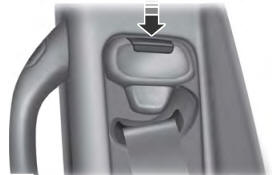Ford Explorer: Climate Control System - General Information / General Procedures - Electronic Leak Detection - Vehicles With: R1234YF Refrigerant
Special Tool(s) / General Equipment
| Electronic Leak Detector |
Inspection
-
NOTE: Use a Rotunda-approved Electronic Leak Detector for R-1234yf refrigerant SAE Certified to J2913.
NOTE: Good ventilation is necessary in the area where electronic A/C leak testing is to be carried out. If the surrounding air is contaminated with refrigerant gas, the leak detector indicates this gas all the time. Odors from other chemicals such as antifreeze, disc brake cleaner or other cleaning solvents can cause the same problem. Using a fan to ventilate the area to be tested before proceeding with the leak detection procedure is helpful in removing small traces of contamination from the air, but the fan should be turned off during actual testing.
NOTE: If the surrounding air is contaminated with refrigerant gas, the leak detector indicates this gas all the time. Odors from other chemicals such as antifreeze, disc brake cleaner or other cleaning solvents can cause the same problem.
NOTE: R-1234yf, if present, is heavier than air, and tends to move down from the source of the leak. It is possible that a leak may not be detected if the leak detector tip is held above the leaking fitting, line or component. Always be sure to thoroughly leak test below, above and around the fitting, line or component for the presence of R-1234yf.
Leak check the service ports. Remove caps and blow air over the service ports to remove trapped refrigerant before leak testing ports.
-
339-D440A Techno Tool SAE Certified Refrigerant Leak Detector.
Use the General Equipment: Electronic Leak Detector
-
023‐LD7 Robinair Premium Refrigerant Leak Detector
Use the General Equipment: Electronic Leak Detector
-
339-D440A Techno Tool SAE Certified Refrigerant Leak Detector.
-
NOTE: The system pressure should be 413-551 kPa (60 - 80 psi) at 24° C (75.2° F) with the engine off and cool. The pressure reading may be higher if the engine is hot.
Leak test the refrigerant system. Follow the instructions included with the Electronic Leak Detector for handling and operation techniques.
 General Procedures - Condenser Core Leak Check - Vehicles With: R1234YF Refrigerant
General Procedures - Condenser Core Leak Check - Vehicles With: R1234YF Refrigerant
Special Tool(s) /
General Equipment
Air Conditioning Service Unit
Air Conditioning Adaptor Kit
Inspection
Recover the refrigerant...
 General Procedures - Evaporator Core Leak Check - Vehicles With: R1234YF Refrigerant
General Procedures - Evaporator Core Leak Check - Vehicles With: R1234YF Refrigerant
Special Tool(s) /
General Equipment
Air Conditioning Service Unit
Air Conditioning Adaptor Kit
Inspection
Recover the refrigerant...
Other information:
Ford Explorer 2020-2025 Service Manual: Description and Operation - Accessory Drive - Component Location
..
Ford Explorer 2020-2025 Service Manual: Removal and Installation - Windshield Washer Reservoir
Special Tool(s) / General Equipment Fluid Suction Gun Fluid Container Materials Name Specification Motorcraft® Premium Windshield Wash Concentrate with BitterantZC-32-B2 WSS-M14P19-A Removal NOTE: Removal steps in this procedure may contain installation details...
Categories
- Manuals Home
- 6th Generation Explorer Owners Manual
- 6th Generation Explorer Service Manual
- Diagnosis and Testing - Parking Brake - Vehicles With: Electric Brake Booster
- Removal and Installation - Liftgate Trim Panel
- Engine - 2.3L EcoBoost (201kW/273PS)
- New on site
- Most important about car
Seatbelt Height Adjustment
WARNING: Position the seatbelt height adjuster so that the seatbelt rests across the middle of your shoulder. Failure to adjust the seatbelt correctly could reduce its effectiveness and increase the risk of injury in a crash.

